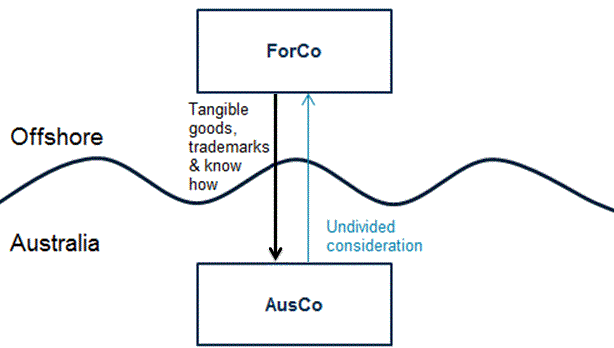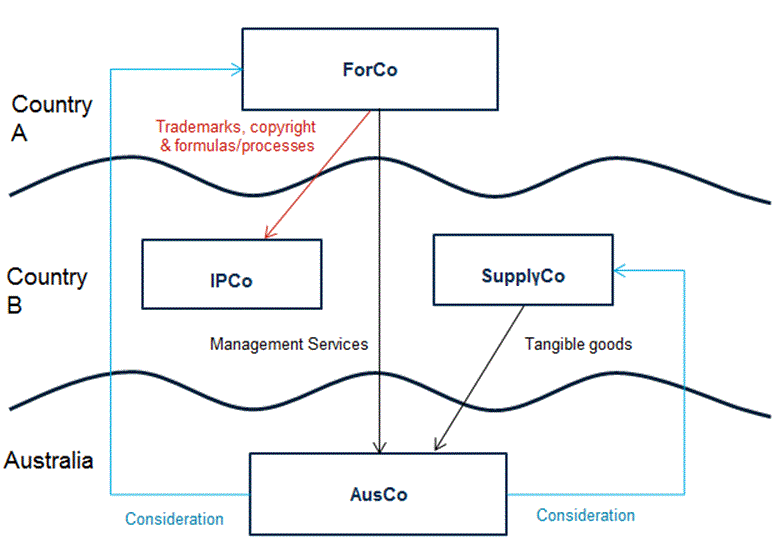Taxpayer Alert
TA 2018/2
Mischaracterisation of activities or payments in connection with intangible assets
| Alerts provide a summary of our concerns about new or emerging higher risk tax or superannuation arrangements or issues that we have under risk assessment.
While an alert describes a type of arrangement, it is not possible to cover every potential variation of the arrangement. The absence of an alert on an arrangement or a variation of an arrangement does not mean that we accept or endorse the arrangement or variation, or the underlying tax consequences. Refer to PS LA 2008/15 for more about alerts. See Alerts issued to date. |
Description
We are currently reviewing international arrangements that mischaracterise intangible assets[1] and/or activities or conditions connected with intangible assets.
Our concerns include whether intangible assets have been appropriately recognised for Australian tax purposes and whether Australian royalty withholding tax obligations have been met. Arrangements that allocate all consideration to tangible goods and/or services, arrangements that allocate no consideration to intangible assets, and arrangements that view intangible assets collectively, or conceal intangible assets, may be more likely to result in a mischaracterisation.
Where arrangements are between related parties, we are concerned about whether the:
- •
- amount deducted by the Australian entity under the arrangement meets the arm's length requirements of the transfer pricing provisions in the taxation law[2]
- •
- functions performed, assets used and risked assumed by the Australian entity, in connection with the arrangement, are appropriately compensated in accordance with the arm's length requirements of the transfer pricing provisions in the taxation law.
These arrangements typically display most, if not all, of the following features:
- •
- intangible assets are developed, maintained, protected or owned by an entity located in a foreign jurisdiction (an 'IP entity')
- •
- the Australian entity enters into an arrangement to undertake an activity or a combination of activities
- •
- the Australian entity requires the use of the relevant intangible assets in order to undertake these activities
- •
- the Australian entity purchases goods and/or services from an IP entity or a foreign associate of an IP entity in order to undertake these activities
- •
- the Australian entity agrees to pay an amount, or a series of amounts, to a foreign entity which the Australian entity does not recognise or treat as wholly or partly being for the use of an IP entity's intangible assets.
This Taxpayer Alert (Alert) does not apply to international arrangements which involve an incidental use of an intangible asset. For example, this Alert does not apply to resellers of finished tangible goods where the activity of reselling the goods involves an incidental use of a brand name that appears on the goods and related packaging. Whether a use is incidental in this sense will depend on an analysis of the true relationship and activities of the parties. The fact that an arrangement fails to expressly provide for the use of an intangible asset does not, in itself, determine that a use is incidental.
Example 1:

An Australian company (AusCo) is party to an agreement with a foreign company (ForCo).
The terms of the agreement provide that AusCo will acquire from ForCo:
- •
- the right to manufacture, market and distribute certain products in the territory of Australia
- •
- manufacturing know how, including secret formulas or processes
- •
- a right to use trademarks
- •
- tangible goods such as raw materials used in the manufacturing process.
AusCo:
- •
- applies the manufacturing know how and tangible goods in the process of manufacturing the product
- •
- uses the trademarks in marketing and distributing the finished product in Australia.
The terms of the agreement provide that AusCo pays a single undivided amount of consideration to ForCo which is stated to be solely for tangible goods.
AusCo and ForCo do not recognise any part of the amount paid by AusCo to ForCo as being consideration for AusCo's use of ForCo's trademarks and manufacturing know how. AusCo and ForCo do not recognise any part of the amount paid by AusCo to ForCo as a royalty. AusCo does not pay any royalty withholding tax on the relevant amount.
This characterisation may not appropriately recognise the exploitation of relevant intangible assets or the functions performed and risks assumed in connection with those intangible assets.
Example 2:

An Australian company (AusCo) is party to an agreement with a related foreign company (ForCo).
The terms of the agreement provide that AusCo:
- •
- is granted the right to manufacture, market and distribute certain products in the territory of Australia
- •
- is obliged to manufacture, market and distribute the relevant products in accordance with the directions of ForCo
- •
- agrees to purchase tangible goods from another foreign company (SupplyCo) which may not be a related party, under a separate contractual arrangement.
Pursuant to the agreement, ForCo is to provide management services to AusCo to assist with the manufacturing, marketing and distribution activities undertaken by AusCo.
ForCo maintains, protects and owns certain intangible assets being trademarks, copyright and formulas/processes associated with the products that AusCo has been granted the right to manufacture, market and distribute.
The agreement between AusCo and ForCo does not grant AusCo the right to use the relevant intangible assets. The terms of agreement provide that AusCo pays a single undivided amount of consideration to ForCo for management services.
ForCo grants IP Company (IPCo), a related party, exclusive use of the relevant trademarks, copyright and formulas/processes in the territory of Australia. IPCo is not a resident of Australia.
AusCo:
- •
- pays SupplyCo an amount for the tangible goods; the amount paid by AusCo to SupplyCo is determined by ForCo
- •
- applies the trademarks and formulas/processes exclusively licensed to IPCo, and the tangible goods purchased from SupplyCo, in the process of manufacturing the products
- •
- uses the copyright and trademarks exclusively licensed to IPCo in marketing and distributing the finished products in the territory of Australia.
IPCo does not enter into an agreement with AusCo, or any other party, granting the right to exploit the relevant intangible assets in the territory of Australia.
It is implicit from AusCo's activities and dealings with ForCo and SupplyCo that, in substance, AusCo is entitled to use the relevant intangible assets that have been exclusively licensed to IPCo in the territory of Australia. AusCo, ForCo and SupplyCo do not recognise any part of the amounts paid by AusCo to ForCo or SupplyCo as being consideration for AusCo's use of IPCo's trademarks, copyright and formulas/processes. AusCo, ForCo and Supply Co do not recognise any part of the amount paid as a royalty. AusCo does not pay any royalty withholding tax on the relevant amount.
The characterisation and remuneration of AusCo may not appropriately recognise the exploitation of the relevant intangible assets or the functions performed, assets used and risks assumed in connection with those intangible assets.
What are our concerns?
We are concerned that parties to arrangements of the type described in this Alert may fail to comply with Australian royalty withholding tax obligations associated with consideration for the use of intangible assets, under Subdivision 12-F of Schedule 1 to the Taxation Administration Act 1953 (TAA 1953). Parties may mischaracterise an undivided amount of consideration, or part thereof, as not being for the use of intangible assets, and may not recognise a royalty. Additionally, parties may be claiming deductions for such payments contrary to section 26-25 of the ITAA 1997.
We are also concerned that the analysis or methodology relied on to determine the arm's length conditions and/or profits connected with arrangements of the type considered in this Alert may result in parties obtaining a transfer pricing benefit. This transfer pricing benefit occurs due to a mischaracterisation of the functions performed, assets used and risks assumed by the Australian entity. In these circumstances, Division 815 of the ITAA 1997 may apply to negate such transfer pricing benefits.
In this Alert, royalty refers to the definition of 'royalty' found in subsection 6(1) of the Income Tax Assessment Act 1936 (ITAA 1936) or the definition of 'royalty' or 'royalties' found in any applicable Australian tax treaty.[3]
We are concerned that arrangements of this type may be entered into or carried out for the dominant or principal purpose of obtaining a tax benefit. This may attract the operation of the general anti-avoidance rules in Part IVA of the ITAA 1936 and/or the application of the diverted profits tax.[4]
What are we doing?
We are currently reviewing these arrangements and engaging with taxpayers who have entered into, or are considering entering into, these arrangements. Compliance activity and engagement will continue as we develop our technical position on these arrangements.
Taxpayers and advisors who enter into these types of arrangements will be subject to increased scrutiny.
What should you do?
If you have entered into, or are contemplating entering into, an arrangement of this type we encourage you to discuss your situation with us by emailing PGIAdvice@ato.gov.au.
Penalties may apply to participants and promoters of this type of arrangement.
Commissioner of Taxation
Date of Issue: 20 November 2018
Date of Effect: N/A
Intangible assets being property, assets and rights that are not physical assets or financial assets, which are capable of being controlled for use in commercial activities as defined in the OECD Transfer Pricing Guidelines for Multinational Enterprises and Tax Administrations 2017 at Chapter VI: Intangibles paragraph 6.6, including trademarks, copyright, designs, know how, patents, secret formulas or processes, or similar property or rights.
As defined in section 995-1 of the Income Tax Assessment Act 1997 (ITAA 1997).
For example, paragraph (3) of Article 12 of the Convention between the Government of Australia and the Government of the United Kingdom of Great Britain and Northern Ireland for the Avoidance of Double Taxation and the Prevention of Fiscal Evasion with respect to Taxes on Income and on Capital Gains in force 17 December, given the force of law in Australia under section 5 of the International Tax Agreements Act 1953.
Further information concerning the application of the diverted profits tax to cross border arrangements in connection with intangible assets is available in Practical Compliance Guideline PCG 2018/5 Diverted profits tax.
Related Practice Statements:
PS LA 2008/15
Other References:
PCG 2018/5OECD Transfer Pricing Guidelines for Multinational Enterprises and Tax Administrations 2017Convention between the Government of Australia and the Government of the United Kingdom of Great Britain and Northern Ireland for the Avoidance of Double Taxation and the Prevention of Fiscal Evasion with respect to Taxes on Income and on Capital Gains
Legislative References:
ITAA 1936
Pt IVA
6(1)
ITAA 1997
26-25
Div 815
995-1
TAA 1953
TAA 1953 5
TAA 1953 Subdiv 12-F Sch 1
Mark Konza
Deputy Commissioner Business Line: Public Groups and International
| Contact officer: | Christopher Ferguson |
| Email address: | PGIIntangiblesMigration@ato.gov.au |
| Address: | Australian Taxation Office
GPO Box 9977 MELBOURNE VIC 3001 |
Copyright notice
© Australian Taxation Office for the Commonwealth of Australia
You are free to copy, adapt, modify, transmit and distribute material on this website as you wish (but not in any way that suggests the ATO or the Commonwealth endorses you or any of your services or products).
